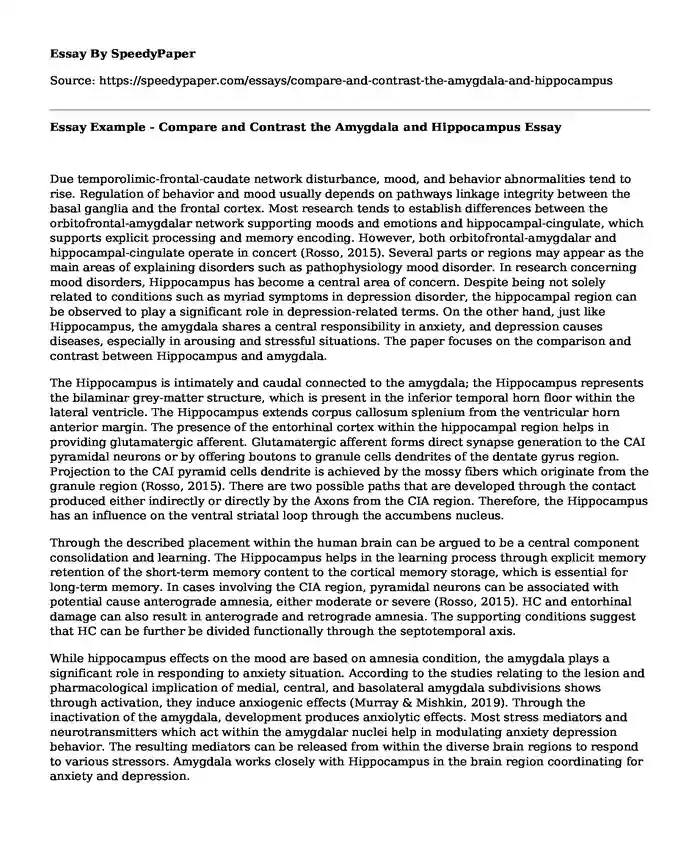
| Essay type: | Compare and contrast |
| Categories: | Medicine Anatomy Disorder Behavior change |
| Pages: | 3 |
| Wordcount: | 647 words |
Due temporolimic-frontal-caudate network disturbance, mood, and behavior abnormalities tend to rise. Regulation of behavior and mood usually depends on pathways linkage integrity between the basal ganglia and the frontal cortex. Most research tends to establish differences between the orbitofrontal-amygdalar network supporting moods and emotions and hippocampal-cingulate, which supports explicit processing and memory encoding. However, both orbitofrontal-amygdalar and hippocampal-cingulate operate in concert (Rosso, 2015). Several parts or regions may appear as the main areas of explaining disorders such as pathophysiology mood disorder. In research concerning mood disorders, Hippocampus has become a central area of concern. Despite being not solely related to conditions such as myriad symptoms in depression disorder, the hippocampal region can be observed to play a significant role in depression-related terms. On the other hand, just like Hippocampus, the amygdala shares a central responsibility in anxiety, and depression causes diseases, especially in arousing and stressful situations. The paper focuses on the comparison and contrast between Hippocampus and amygdala.
The Hippocampus is intimately and caudal connected to the amygdala; the Hippocampus represents the bilaminar grey-matter structure, which is present in the inferior temporal horn floor within the lateral ventricle. The Hippocampus extends corpus callosum splenium from the ventricular horn anterior margin. The presence of the entorhinal cortex within the hippocampal region helps in providing glutamatergic afferent. Glutamatergic afferent forms direct synapse generation to the CAI pyramidal neurons or by offering boutons to granule cells dendrites of the dentate gyrus region. Projection to the CAI pyramid cells dendrite is achieved by the mossy fibers which originate from the granule region (Rosso, 2015). There are two possible paths that are developed through the contact produced either indirectly or directly by the Axons from the CIA region. Therefore, the Hippocampus has an influence on the ventral striatal loop through the accumbens nucleus.
Through the described placement within the human brain can be argued to be a central component consolidation and learning. The Hippocampus helps in the learning process through explicit memory retention of the short-term memory content to the cortical memory storage, which is essential for long-term memory. In cases involving the CIA region, pyramidal neurons can be associated with potential cause anterograde amnesia, either moderate or severe (Rosso, 2015). HC and entorhinal damage can also result in anterograde and retrograde amnesia. The supporting conditions suggest that HC can be further be divided functionally through the septotemporal axis.
While hippocampus effects on the mood are based on amnesia condition, the amygdala plays a significant role in responding to anxiety situation. According to the studies relating to the lesion and pharmacological implication of medial, central, and basolateral amygdala subdivisions shows through activation, they induce anxiogenic effects (Murray & Mishkin, 2019). Through the inactivation of the amygdala, development produces anxiolytic effects. Most stress mediators and neurotransmitters which act within the amygdalar nuclei help in modulating anxiety depression behavior. The resulting mediators can be released from within the diverse brain regions to respond to various stressors. Amygdala works closely with Hippocampus in the brain region coordinating for anxiety and depression.
Most of the amygdaloid output arises from medial, central, accessory basal, and lateral basal amygdaloid nuclei, each with a different distribution pattern. There is a high projection that appears from the Ch4 region within Ch4p, Chiv, Ch4al subdivisions. Another basal forebrain region, however, provides minimal amygdala input. However, the Hippocampal efferent is terminated mostly within the dorsal septum, lateral, and medial (Ch1). As opposed to the amygdala region, the Hippocampal efferent is not highly ended in the Ch4 and tubercle olfactory part.
References
Rosso, I. M., Cintron, C. M., Steingard, R. J., Renshaw, P. F., Young, A. D., & Yurgelun-Todd, D. A. (2015). Amygdala and hippocampus volumes in pediatric major depression. Biological psychiatry, 57(1), 21-26. https://www.sciencedirect.com/science/article/pii/S0006322304011072
Murray, E. A., & Mishkin, M. (2019). Severe tactual, as well as visual memory deficits, follow the combined removal of the amygdala and Hippocampus in monkeys. Journal of Neuroscience, 4(10), 2565-2580. https://www.sciencedirect.com/science/article/pii/S0006322314003515
Cite this page
Essay Example - Compare and Contrast the Amygdala and Hippocampus. (2023, Aug 02). Retrieved from https://speedypaper.com/essays/compare-and-contrast-the-amygdala-and-hippocampus
Request Removal
If you are the original author of this essay and no longer wish to have it published on the SpeedyPaper website, please click below to request its removal:
- Free Essay Example: Electromagnetic Radiation, Visible Light and Human Health
- Free Essay on the Methodology of Maximizing the Profit Margin of MEP Projects
- Free Essay about Ebola Virus in Sierra Leone
- Free Essay about the Behavior of Children on the Autism Spectrum
- Opioid Crisis - Free Paper Sample
- The Mechanism of Leukocytosis in Acute Inflammation - Essay Sample
- Paper Sample on Genetics
Popular categories




